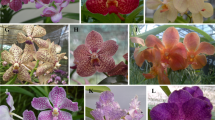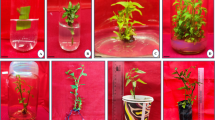Abstract
An efficient callus proliferation system for Rheum franzenbachii Munt., a rare medicinal plant, has been developed. Callus induced from leaf explants incubated on Murashige and Skoog (MS) medium with appropriate supplements of plant growth regulators. In the 6-benzylaminopurine (6-BAP) in combination with α-naphthalene acetic acid (NAA) treatments, different concentrations of NAA showed different induction effects on explants. When concentration of 6-BAP was as high as 2.0 mgl−1 in combination with 0.5 mgl−1 NAA, the callus induction rate reached 58.3%. N-phenyl-N’-1,2,3-thiadiazol-5-ylure (TDZ) in combination with NAA was very suitable for callus proliferation compared to TDZ in combination with 2,4-dicholorophenoxy acetic acid (2,4-D) or TDZ in combination with indole-3-acetic acid (IAA). Fresh and dry weight of callus cultured on MS medium supplemented with 0.5 mgl−1 TDZ in combination with 0.2 mgl−1 NAA increased 26.3 and 15.0 times within 35 days culture, respectively. Quantitative analysis of rhaponticin by HPLC showed that the phytochemical profile of callus was similar to that of wild plants, and the content of rhaponticin in callus cultured on MS medium supplemented with 0.5 mgl−1 TDZ and 0.2 mgl−1 NAA was 16.6 mgg−1DW compared to that of 4.0 mgg−1 DW in wild plants.



Similar content being viewed by others
Abbreviations
- BAP:
-
6-Benzylaminopurine
- IAA:
-
Indole-3-acetic acid
- NAA:
-
Naphthaleneacetic acid
- TDZ:
-
Thidiazuron
- 2,4-D:
-
2,4-dicholorophenoxy acetic acid
- MS:
-
Murashige and Skoog
References
Bourgaud F, Gravot A, Milesi S, Gontier E (2001) Production of plant secondary metabolites: a historical perspective. Plant Sci 161:839–851
Brent T, Steven FV (2008) Growth, morphogenesis, and essential oil production in Mentha spicata L. plantlets in vitro. In Vitro Cell Dev Biol-Plant 44:40–50
Choi SB, Ko BS, Park SK (2006) Insulin sensitizing and a-glucoamylase inhibitory action of sennosides, rhein and rhaponticin in Rhei Rhizoma. Life Sci 78(9):934–942
Dhandapani M, Kim DH, Hong S-B (2008) Efficient plant regeneration via somatic embryogenesis and organogenesis from the explants of Catharanthus roseus. In Vitro Cell Dev Biol Plant 44:18–25
Flora of China Editorial Committee of Chinese Academy of Sciences (1984) Flora of China. Science Press, 171–172
Guo B, Gao M, Liu CZ (2007) In vitro propagation of an endangered medicinal plant Saussurea involucrata Kar. et Kir. Plant Cell Rep 26:261–265
Hu RL, Zhu BC (1989) Leaves tissue culture of medicinal plant Rheum franzenbachii Munt. J Hebei Univ Nat Sci Ed 11(4):55–58
Jain R, Sinha A, Jain D, Kachhwaha S, Kothari SL (2011) Adventitious shoot regeneration and in vitro biosynthesis of steroidal lactones in Withania coagulans (Stocks) Dunal. Plant Cell Tiss Org Cult 105(1):135–140
Kim DH, Park EK, Bae EA (2000) Metabolism of rhaponticin and chrysophanol 8-o-β-D-glucopyranoside from the rhizome of rheum undulatum by human intestinal bacteria and their anti-allergic actions. Biol Pharm Bull 23(7):830–833
Makunga NP, van Staden J (2008) An efficient system for the production of clonal plantlets of the medicinally important aromatic plant: Salvia africana-lutea L. Plant Cell Tiss Organ Cult 92:63–72
Murashige T, Skoog F (1962) A revised medium for rapid growth and bioassays with tobacco tissue cultures. Physiol Plant 15:473–497
Ngoc TM, Minh PTH, Hung TM (2008) Lipoxygenase inhibitory constituents from rhubarb. Arch Pharm Res 31(5):598–605
Park EK, Choo MK, Moon HK (2002) Antithrombotic and antiallergic activities of rhaponticin from Rhei Rhizoma are activated by human intestinal bacteria. Arch Pharm Res 25(4):528–533
Rao SR, Ravishankar GA (2002) Plant cell cultures: chemical factories of secondary metabolites. Biotechnol Adv 20:101–153
Ryu SY, Choi SU, Lee CO (1994) Antitumor activity of some phenolic components in plants. Arch Pharm Res 17(1):42–44
Sangwan RS, Chaurasiya ND, Lal P, Misra L, Uniyal GC, Tuli R, Sangwan NS (2007) Withanolide A biogeneration in in vitro shoot cultures of ashwagandha (Withania somnifera Dunal), a main medicinal plant in ayurveda. Chem Pharma Bull 55:1371–1375
Vanisree M, Lee CY, Lo SF, Nalawade SM, Lin CY, Tsay HS (2004) Studies on the production of some important secondary metabolites from medicinal plants by plant tissue cultures. Bot Bull Acad Sin 45:1–22
Verpoorte R, Contin A, Memelink J (2002) Biotechnology for the production of plant secondary metabolites. Phytochem Rev 1:13–25
Wang AQ, Li JL, Wu ZZ (2001) Studies on stilbenes in Rheum franzenbachii. Chin Tradit Herb Drugs 32(10):878–880
Wang AQ, Li JL, Wu ZZ (2003a) Studies on non-stilbenes in Rheum franzenbachii. Chin Tradit Herb Drugs 34(8):685
Wang JL, Liao XR, Zhang HM, Du JF, Chen PL (2003b) Accumulation of chlorogenic acid in cell suspension cultures of Eucommia ulmoides Oliv. Plant Cell Tiss Organ Cult 74(2):193–195
Wang JL, Wang Q, Wang J, Lu Y, Xiao X, Gong WZ, Liu JK (2009) Effect of different plant growth regulators on micro-tuber induction and plant regeneration of Pinellia ternate (Thunb) Briet. Physiol Mol Biol Plants 15(4):359–365
Wang JL, Wang J, Liu K, Xiao X, Gong WZ, Lu Y, Liu MF, Xu DT (2010) An efficient plant regeneration system with in vitro flavonoid accumulation for Hylotelephium tatarinowii (Maxim.) H. Ohba. In Vitro Cell Dev Biol-Plant 46:445–450
Wang XD, Bi JJ, Huang LH (2007) HPLC determination of rhaponticin in Rheum hotaoense C.Y. Cheng et T.C.Kao. Bull Acad Mil. Med Sci 31(5):498–499
Acknowledgment
This work was financially supported by National Basic Research Program of China (973 Program, 2009CB522300), the Fund of State Key Laboratory of Phytochemistry and Plant Resources in West China (09708211Z1), Program of State Ethnic Affairs Commission (09ZY09), the “985” Project (MUC985) , “111” Project (B08044) and the Fundamental Research Funds for the Central Universities (0910KYZY46).
Author information
Authors and Affiliations
Corresponding author
Rights and permissions
About this article
Cite this article
Wang, J., Lu, Y., Wang, Q. et al. An efficient callus proliferation protocol and rhaponticin accumulation of Rheum franzenbachii Munt., a medicinal plant. J. Plant Biochem. Biotechnol. 20, 252–257 (2011). https://doi.org/10.1007/s13562-011-0055-4
Received:
Accepted:
Published:
Issue Date:
DOI: https://doi.org/10.1007/s13562-011-0055-4




